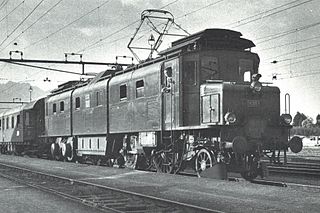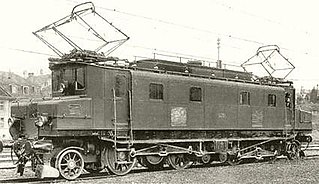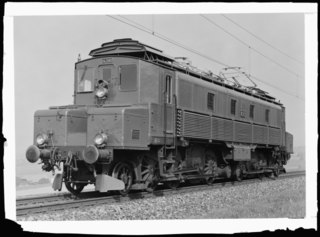
The British Railways Class D3/7 were a class of 0-6-0 diesel electric shunting locomotives built as LMS Nos. 7080–7119. The class were built from May 1939 through to July 1942 by the London, Midland and Scottish Railway at their Derby Works using a diesel electric transmission supplied by English Electric.

HS4000 Kestrel was a prototype high-powered mainline diesel locomotive built in 1967 by Brush Traction, Loughborough as a technology demonstrator for potential future British Rail and export orders. The locomotive number is a combination of the initials of Hawker Siddeley and the power rating of its Sulzer diesel engine, making it the most powerful locomotive built by the company.

Crocodile electric locomotives are so called because they have long "noses" at each end, reminiscent of the snout of a crocodile. These contain the motors and drive axles, and are connected by an articulated center section. The center section usually contains the crew compartments, pantographs and transformer.

The DB Class 101 is a class of three-phase electric locomotives built by Adtranz and operated by DB Fernverkehr in Germany. 145 locomotives were built between 1996 and 1999 to replace the 30-year-old and aging Class 103 as the flagship of the Deutsche Bahn, primarily hauling Intercity services. This class encompasses the latest generation of locomotives of the Deutsche Bahn.

A jackshaft is an intermediate shaft used to transfer power from a powered shaft such as the output shaft of an engine or motor to driven shafts such as the drive axles of a locomotive. As applied to railroad locomotives in the 19th and 20th centuries, jackshafts were typically in line with the drive axles of locomotives and connected to them by side rods. In general, each drive axle on a locomotive is free to move about one inch (2.5 cm) vertically relative to the frame, with the locomotive weight carried on springs. This means that if the engine, motor or transmission is rigidly attached to the locomotive frame, it cannot be rigidly connected to the axle. This problem can be solved by mounting the jackshaft on unsprung bearings and using side-rods or chain drives.

Bombardier TRAXX is a modular product platform of mainline diesel-electric and electric locomotives produced by Bombardier Transportation, which was built in both freight and passenger variants. The first version was a dual-voltage AC locomotive built for German railways from the year 2000. Later types included DC versions, as well as quadruple-voltage machines, able to operate on most European electrification schemes: 1.5/3.0 kV DC and 15/25 kV AC. The family was expanded in 2006 to include diesel-powered versions. Elements common to all variants include steel bodyshells, two bogies with two powered axles each, three-phase asynchronous induction motors, cooling exhausts on the roof edges, and wheel disc brakes.

The Re 620, Re 6/6 in the old numbering scheme, are six-axle, electric locomotives of the SBB-CFF-FFS, which were acquired as a replacement for the Ae 6/6 for heavy services on the Gotthardbahn. They are the most modern of the so-called "Gotthard locomotives".

The Ae 4/7 was a universal locomotive of the Swiss Federal Railways, employing the so-called Buchli drive.

The Ae 4/8 was a prototype locomotive of the Schweizerischen Bundesbahnen (SBB) for the testing of electrical operation. The locomotive was equipped with two different drives, therefore acquiring the nickname Bastard. Because of its three-part locomotive body it also acquired the nickname Tatzelwurm.

The Be 3/5 11201 was one of four test locomotives ordered by the Schweizerischen Bundesbahnen (SBB) in June 1917. Intended to provide experience with electric traction, the locomotive was intended, along with Be 4/6 12301, Be 4/6 12302 and Ce 6/8I14201, to be used on services on the Gotthardbahn. The Be 3/5 was something of a stopgap offered by Maschinenfabrik Oerlikon (MFO) because they felt that the requirements required for the Gotthard Railway could not be fulfilled at the time. As the MFO did not feel that it could produce a freight locomotive with six drive-axles, a smaller version of the BLS Be 5/7 was offered. This meant that the locomotive did not fulfil the SBB specifications for the Gotthard line; it was too weak and, compared with the A 3/5 steam locomotives, too slow. However, due to a lack of available stock, the railway still took delivery of the locomotive, a decision later proved correct by the long operational life and reliability of the Be 3/5.

The Be 4/6 12301 was one of four test locomotives ordered by the Schweizerische Bundesbahnen (SBB) in June 1917. For gaining experience for ordering electrical locomotives this locomotive should – as her three sisters Be 3/5 12201, Be 4/6 12302 and Ce 6/8I14201 – have been used for services on the Gotthardbahn. The Be 4/6 12301 was the alternative design of MFO for a fast train locomotive for the Gotthard railway line. She was designed and built according to the requirement specifications of the SBB. But – except for occasional trips to the maintenance shop of Bellinzona – did not appear on the Gotthard railway line. The design was intrinsically reliable. The locomotive was operating during 44 years in very various services. The locomotive drivers liked the locomotive because her driving behaviour was very smooth even at top speed. But technically the locomotive was much more complicated than their sisters Be 4/6 12302 and Be 4/6 12303-12342.

The Ce 6/8 I 14201 was one of four test locomotives ordered by the Schweizerischen Bundesbahnen (SBB) in June 1917. For gaining experience for ordering electrical locomotives this locomotive should – as her three sisters Be 3/5 12201, Be 4/6 12301 and Be 4/6 12302 – have been used for services on the Gotthardbahn. The development of freight locomotives subsequently took a complete different way which was not conceivable at the ordering date. The Ce 6/8I came into service only after the first Ce 6/8II.

The Brig-Visp-Zermatt-Bahn Deh 4/4, now known as the Matterhorn Gotthard Bahn Deh 4/4 21–24, is a four member class of metre gauge, rack rail, electric multiple unit power cars operated until 2002 by the Brig-Visp-Zermatt-Bahn (BVZ), and since then by its successor, the Matterhorn Gotthard Bahn (MGB), in the Canton of Valais, Switzerland.

The VL85 is a Soviet built electric mainline freight locomotive manufactured at the Novocherkassk Electric Locomotive Plant (NEVZ) and designed under the management of V.Ya.Sverdlov (ru:В.Я.Свердлов).

The 2BB2 400 class were two electric locomotives built in 1926 for the Paris Orléans (PO) railway of France.

The Be 4/6 was a bogie locomotive operated by the Schweizerischen Bundesbahnen (SBB) on the Gotthard Railway along with the Be 3/5, The design was based on the prototype Be 4/6 12302.

The Swiss locomotive class Ae 4/6 was a class of electric locomotives. They were intended as a powerful locomotive for the steep gradients of the Gotthard Railway, but smaller than the huge 'double locomotives' which had previously been tested there. They were built from 1941, during WWII, and although Switzerland remained neutral through this, material shortages led to some quality problems with these locomotives.
The FS Class E.470 was an electric locomotive class of the state-owned Italian railway Ferrovie dello Stato. It was used on the Italian three-phase test line from Rome-Sulmona especially in express train service. After the end of the trial operation in 1945, the locomotives were scrapped, and no locomotive of the class has been preserved.

Rigid-framed electric locomotives were some of the first generations of electric locomotive design. When these began the traction motors of these early locomotives, particularly with AC motors, were too large and heavy to be mounted directly to the axles and so were carried on the frame. One of the initial simplest wheel arrangements for a mainline electric locomotive, from around 1900, was the 1′C1′ arrangement, in UIC classification.

The Indian locomotive class WCG-1 is a class of 1.5 kV DC electric locomotives that was developed in late 1920s by Vulcan Foundry and Swiss Locomotive and Machine Works (SLM for Indian Railways. The model name stands for broad gauge, Direct Current, Freight traffic engine, 1st generation. They entered service in 1930. A total of 41 WCG-1 was built at England between 1928 and 1929.




















